In-Sights for Aavartana
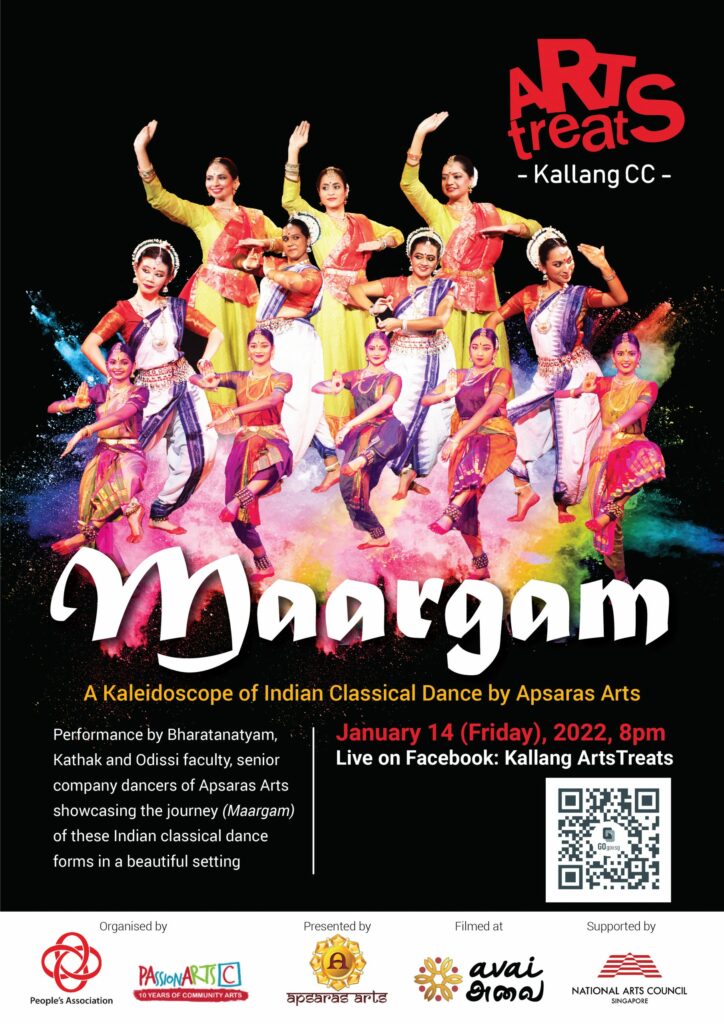
Our In-Sights section of Aavartana is our platform to share the many events, initiatives and happenings in the world of Apsaras Arts. We are looking forward to 2022 and all the many things it has to offer and we are hoping to make the most of it all. So, here’s a lowdown on events brewing, in-house. We begin our year – not a matter of coincidence, at the onset of the year – with Maargam, a presentation by the senior company dancers of Apsaras Arts Dance Repertory. The presentation will feature items from across dance styles – Bharatanatyam, Kathak and Odissi – showcasing at the Kallang Community Club, Singapore. Our Nadopasana series that is our endeavour to remember our founder, Shri S Sathyalingam, with a performance titled Swara Stories – From my Music Classroom by Chitra Poornima Sathish in collaboration with Bombay V Anand (violin) and Ramanan Thiruchittampalam (mridangam) on January 29th at 7.30pm on the AVAI platform. On February 6, we are gearing up to present the first edition of the Indian Performing Arts Convention (IPAC) Symposium on Bharatanatyam in Singapore at the Esplanade Theatre Studio that will also unfold, digitally. Our exciting line-up includes the Convenor’s Keynote address by Aravinth Kumarasamy; Innovating Bharatanatyam Choreography that includes Re-imagining Alarippu by Sreedevy Sivarajasingam mentored by Priyadarsini Govind and Exploring Trikala Jathis by Lakshmi Krishnan mentored by Sheejith Krishna; Bharatanatyam Pedagogy in Singapore, a research paper presentation by Roshini Pillay Keshavan; Perspectives go Abhinaya that includes Exploring Padams by Vardhini Subramaniam mentored by Bragha Bessell demonstrated by Madhuri Suresh and Seema Hari Kumar; Choreography Design for Ensemble Repertoire that includes Designing Dance Vocabulary for Bharanatyam Ensemble works at Apsaras Arts Company by Mohanapriyan Thavarajah, demonstrated by Company Dancers of Apsaras Arts; Millennial Adavus by Dr Apoorva Jayaraman and Shweta Prachande, mentored by Priyadarsini Govind; Panel Discussion on Audience Experience of Bharatanatyam featuring panelists Sri Ganesh Lakshminarayan, Jayashrree Govind, Vidhya Nair, T Dharmendra, Vidhya Venkat, moderated by Seema Hari Kumar; Composing Music for Dance, a conversation with Dr Rajkumar Bharathi with Chithra Poornima Sathish; Approach to Contemporary Dance, a conversation between Akram Khan and Mavin Khoo. Under the umbrella of our annual Neila Sathyalingam Festival, to mark the birth anniversary of Neila Maami, on February 8, on Avai, we present Kadambam, a dance bouquet offering by the Bharatanatyam, Kathak and Odissi students of Apsaras Arts Academy. On February 12, as part of the same festival, we are privileged and proud to present Dr Apoorva Jayaraman and Shweta Prachande, disciples of Priyadarsini Govind, in an exclusive live performance in Singapore titled Anvaya, that will unfold on AVAI. Ten years ago, we premiered a beautiful production titled Nirmanika at the Esplanade Theatres on the Bay. The production had an overwhelming response and we are so excited to have re-visited it and present Nirmanika Re-Imagined on February 26. With a new cast and with new segments, the production unveils itself as a re-envisaged version of its old. We can’t wait to share it all with you!
Point of View
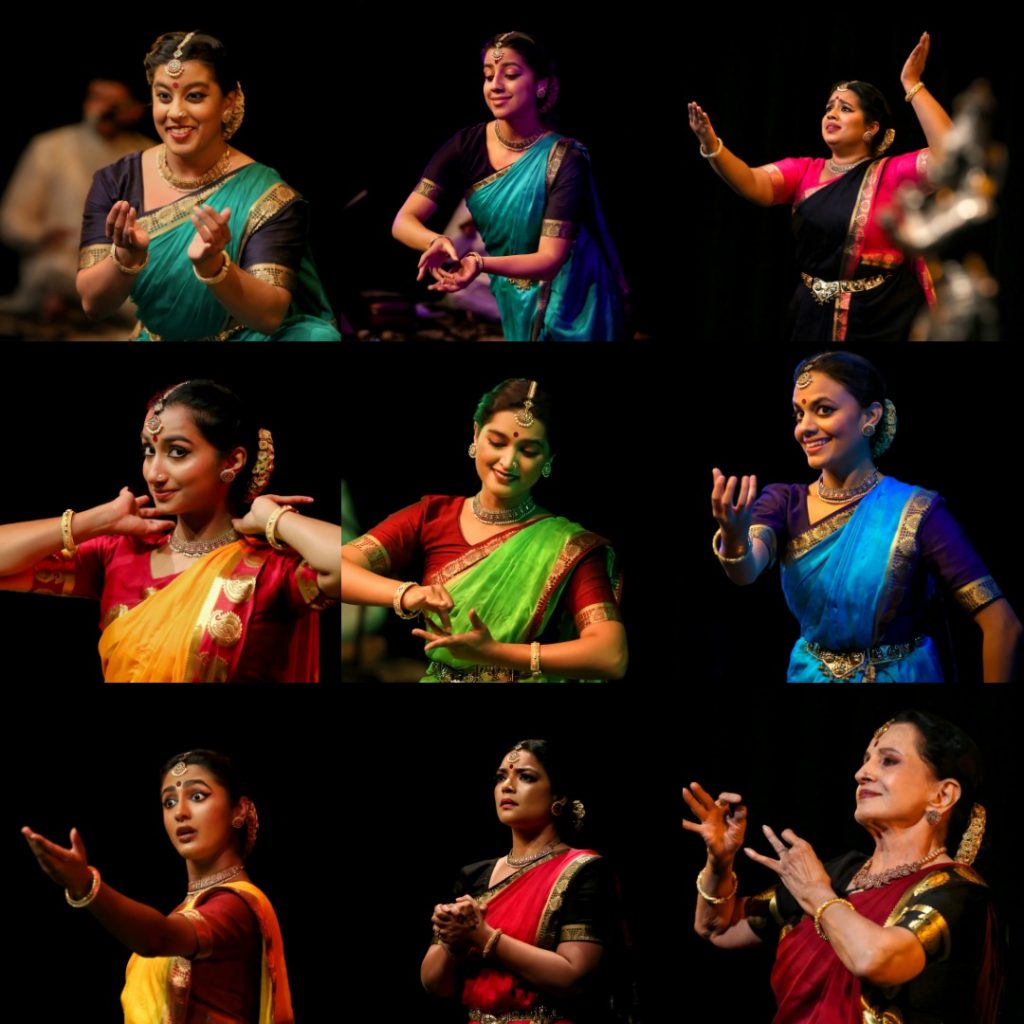
Canada-based dancer-choreographer and founder of Sampradaya Dance Creations in Toronto, Canada, shares her thoughts on the impact of the pandemic on her company and the arts in general. The pandemic was unprecedented and dramatic in its impact on the arts across the globe. One was totally unprepared for having to shut down and to cease operations so abruptly. Performances were cancelled, new creations left half completed and a general sense of alarm and anxiety about the future. Artists who have always lived on marginal livelihoods faced a precarious situation of having to consider giving up a life in the arts. For Sampradaya Dance Creations, it was imperative to stay in operation, to nurture our dancers and staff. To provide them emotional and financial support, continued use of our studios to rehearse to create. We in Canada were very fortunate to receive subsidies from the Government to support our operations, pay rent and overheads while our revenue sources had completely stopped. It was a time for introspection; to uncover the meaning and value of dance for each of us individually and how to make it more authentic, meaningful and impactful for our audiences and to society. We embraced the concept of sharing dance digitally through commissioned works, dance festivals, series and conversations. Supporting emerging artists through online mentored choreographic residencies was a priority for Sampradaya. A clear sense of a global community of dance artists emerged through the digital exchanges of dance conversations. Amidst the sense of isolation the pandemic forced upon us, the blessing of technological connectivity and new collaborative initiatives was a distinct breakthrough. I saw that there would be no turning the clock back; as we all prepared for a new era of hybrid offerings of live and streamed performances, well produced dance films and multi-disciplinary works showcased online Today, we see a return to in person classes and rehearsals for new productions. Audiences who were wary of in-theatre performances are eager for live performances and willing to go through the various steps of safety protocol. Larger theatres with Broadway scale shows are seeing encouraging levels of audience attendance. Live streaming of international dance productions has exponentially increased the offerings that one rarely had access to. Today we are on the threshold of a promising future of dance connectivity that can lead to engagement, collaboration, activism. We have the right to have a voice for the future. BOX
The France Tour
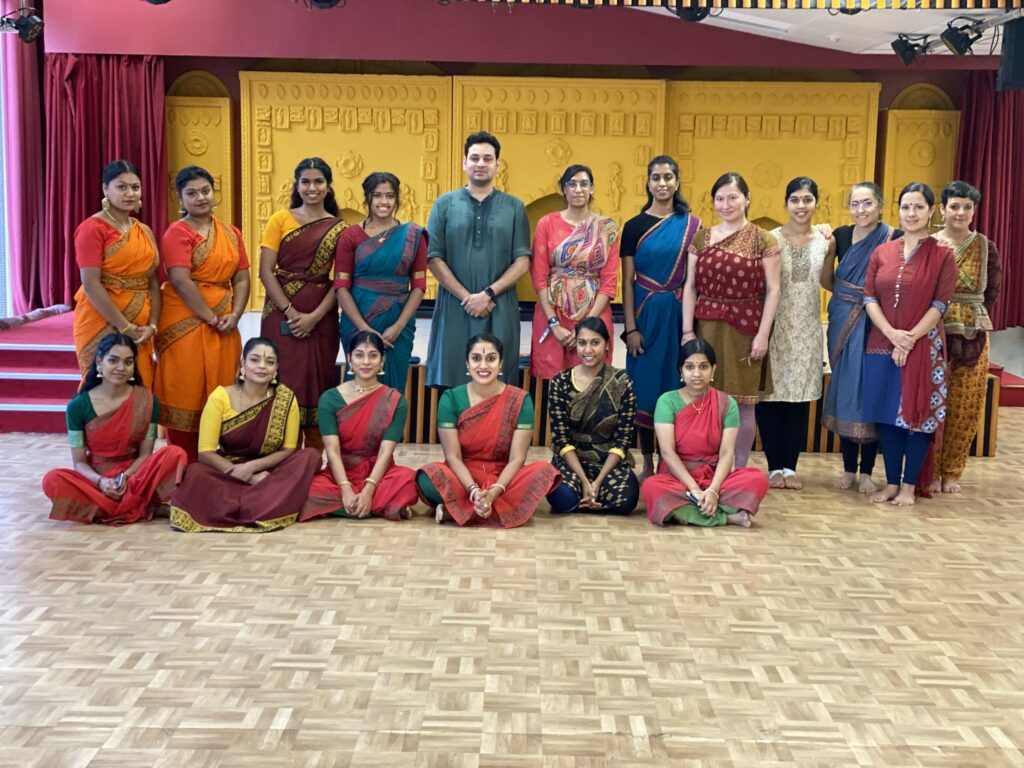
A detailed report of Apsaras Arts tour to France Over the years, France, as a country, has emerged as a hub for the performing arts and is an important destination in the international touring calendar of Apsaras Arts. We, at Apsaras Arts, have had the privilege of visiting France with our work and workshops for nearly 20 years now, and our most recent multi-city tour – spread across a month, where we toured —— cities across the length and breadth of France – marks our third tour to this country that is truly a connoisseur of the Indian classical arts, especially Bharatanatyam. Our recent tour that began in October and culminated in November, had our Artistic Director, Aravinth Kumarasamy and our Principal Choreographer, Mohanapriyan Thavarajah, as the ambassadors of the arts for Apsaras Arts, taking a big slice of Bharatanatyam across venues and spaces in France where we were, yet again, overwhelmed with the keenness and knowledge of the French on matters of the arts; we were moved immensely by their interest in the Indian epics and in a sense, this reinforces the fact that as a country, France has a lot of ties and connections with Asia that has fostered its understanding and appreciation of all things related to Indian arts. The proof, as they say, is in the pudding. We know of a slew of French nationals, who have, over the decade, formally studied Bharatanatyam. Guru Muthuswamy Pillai, a nattuvanar, who lived in France, went on to create and leave behind a legacy in the form of students who have continued their practice and performance of this art form. Over the decades, a whole host of students have travelled to the Kalakshetra in Chennai to train in dance at the institution and also from other gurus based in Chennai, India, and its adjoining areas. The France Tour: An Overview Our France tour, this time comprised of a series of performances, talks, masterclasses, film screenings and discussions. Needless to add, the response was overwhelming. Our shows – performances of our solo productions, Parama Padam and Thandav – performed by Mohanapriyan Thavarajah had full houses across venues that housed audiences between 300 and 600. We also had the opportunity of screening our films, Amara and Sita, across Strasbourg and Paris, for an invited audience and it was heart-warming to have always more than a hundred guests – diverse and eclectic comprising dancers, students of the arts, visual artists, curators of museums, and an invested community of connoisseurs – who were soaked in the film and were keen to share their perspectives and listen to our insights on the films and their making. For us, no tour is complete without a workshop where we have the opportunity to interact with the dance fraternity; practitioners and performers of the dance who have the possibility of keeping the art form alive and bustling. The two workshops helmed by Mohanapriyan Thavarajah at Strasbourg were organised by Vidyalaya, an institution helmed by Rajarajeswari Parisot, a resident of France for over 40 years. A dancer-choreographer from Pondicherry, India, Parisot is an economist, a PhD holder, and as a retired lecturer from the University, her singular focus has been to promote Indian arts in France. The workshop saw a healthy participation from the students of the institution who attended it with enormous enthusiasm and energy. Incidentally, this workshop marks their third with Apsaras Arts, conducted by Mohanapriyan Thavarajah. In fact, for our performance of Parama Padam at Strasbourg, the students of Vidyalaya, performed a Pushpanjali at the foyer of the auditorium, welcoming the audience and setting the tone for what was to come. Incidentally, the students had learnt this Pushpanjali from Mohanapriyan during our workshop for them in 2019. Genesis of IPAC France Significant amongst other things was also the genesis of IPAC France by Apsaras Arts, heralding our foray into France, annually. The workshop therefore became the opening act, the inauguration of the Indian Performing Arts Convention (IPAC, for short) in France and was conducted at the Indira Gandhi Hall at the university. The workshop, for us, meant the possibility of meeting a host of dancers from in and around Paris, who are trained formally in Bharanatyam for over 8 years, and are filled with curiosity to further their art. Forging Collaborations: Moving Forward Interactions and conversations like these help us strengthen our connections with the dance fraternity in France and forge relationships that have the potential of making a significant impact on the arts landscape of the country. This tour also had us forge a collaboration with the Embassy of India in Paris. The Embassy was responsible for organising four events for Apsaras Arts that included the performance of Parama Padam in Paris, the performance of Tandav in Cannes and Nice and the films screening of Amara that was followed by a discussion on the film, in Paris. As an institution, we have always believed in the spirit and the power of collaboration and we are happy, yet again, that we managed to start a conversation with the Singapore Embassy in Paris – we had eminent persons from the Embassy attend our performance of Parama Padam and the screening of our film, Sita. Conversations are also underway with the Sri Lankan embassy in Paris and we are hoping that these conversations will translate into meaningful collaborations in near future. Highlights As a dance repertory company steeped in tradition but conscious of the dynamic world where dance lives and breathes in, it is always heart-warming to share and present productions that we create with thought, imagination and integrity that are inspired as much by ancient epics and mythology as they are about the world that we live in. Our France tour this time had two talking points – Parama Padam and Tandav – both solo productions, by Apsaras Arts, presented and performed by Mohanapriyan Thavarajah. With exposure to the traditional Margam repertoire, for audiences in France, the possibility of witnessing a solo thematic dance production
#iamayoungdancer

Inspired by our campaign, #iamayoungdancer that we began in 2019, we, at Apsaras Arts, have been keen to listen to the voices of young dancers from across the globe. In an attempt to allow them an opportunity to share their challenges and aspirations, and do that with a peer, our section #iamayoungdancer, that unfolds as a video conversation, will articulate some of the concerns and desires of young dancers from around the world. We kickstart this edition with a conversation between Singapore-based Periyachi Roshini and Australia-based Rukshikaa Elankumaran.
The Bookshelf

Books Banter “What can Henry David Thoreau teach me about dance, wonders New York-based dancer-choreographer and academic, Maya Kulkarni letting us foray into Thoreau’s writing and her own response to it “ I have been re-reading Henry David Thoreau’s works, the Walden Pond, an all-time American Classic, particularly The Winter Walk, he wrote in 1843. Thoreau’s writings have absolutely no connection to dance. I read it for the sheer poetry and the magical spell he weaves when he takes me on a cold New England morning through the frozen landscape of the woods in Massachusetts. All is still and cold. Now, what has this to do with dance? Nothing really. But I find Thoreau’s writings nourish my creative urge. First, the quest for getting to the essence of things through detailing the smallest, minutest event in the life of a forest: the journey of a fallen leaf, twisting and turning with the eddies of the Walden Pond is an event. The faint scratch marks in the soft snow are a testimony to the million tiny creatures, the slow drift of snow vapours that hug the tree stems, linger over leaves, wrap through the branches to meet the weak tops alight with gentle rays of the sun, is an event. This attention to slow progression teaches me how the turn of the head in dance, the tension in the averted neck, the rise and fall of a shoulder, is an event that will concretize a character, and enrich the visual poetry of the ‘told’ narrative. The details create word pictures that must carry the essence of things at their heart. There is an oppositional way to create meaning: stillness can be defined by movement. Pauses say much, that a flurry of fancy movements might fail to do. Thoreau’s Nature has a purpose, a mood, and character: the ‘forlorn’ call of the owl, the ‘cheerful’ chirping of small, winged creatures, the slow ‘ponderous’ slide of a worm on the leaf, the ‘lonely’ woods and the ‘stillness’ of snowclad dawn that awaits the ‘burning’ that is to come. I too have tried in my works to endow creatures with human character and vulnerabilities. My Adventures of the Naughty Bee depicts the flighty and mischievous bee; the peacock in another composition is a show-off, proud and slightly wicked. Reading of the Winter Walk inspires a mood narrative. Finally, there is the essence of things: I too look for a central idea with which to begin, thread, and end. Comparison with a literary genius such as Thoreau is unseemly, I admit, but can I not draw on the rich experience that comes from a deeper reading of his work? On Our Bookshelf On Our Bookshelf Karnataka’s Rich Heritage – Temple Sculptures & Dancing Apsaras:An Amalgam of Hindu Mythology, Natyasastra and Silpasastra 1st Edition by Lalit Chugh Amongst all Hindu sculptures, sculpture of Nataraja, the dancing Siva, is perhaps the most popular. Over years, scientists, philosophers, artistes, scholars, writers, art collectors, archaeologists, mythologists, have dabbled with its form, content, philosophy, making it their subject of research, writing and conversation. Karnataka, and its temple architecture tradition, have played a pioneering role in giving an artistic form to this convergence in its temple sculptures. Though this trend may have started earlier during 2nd and 3rd century CE, it is believed that it took center stage from the times of the Badami Chalukyas. Passing through various refinements between 5th and 10th centuries, it reached its peak with the Hoysala art. This book traces the history of temple sculpture evolution and development through the centuries by referring to the existing sculptural forms and the canonical literature that developed over time. In this book, Lalit Chugh, a post-graduate in Physics from Delhi University, who has been working on heritage preservation issues, sheds light on the convergence between Hindu mythology, Natya Sastra and Silpasastra.
De-Constructing Tryambakam
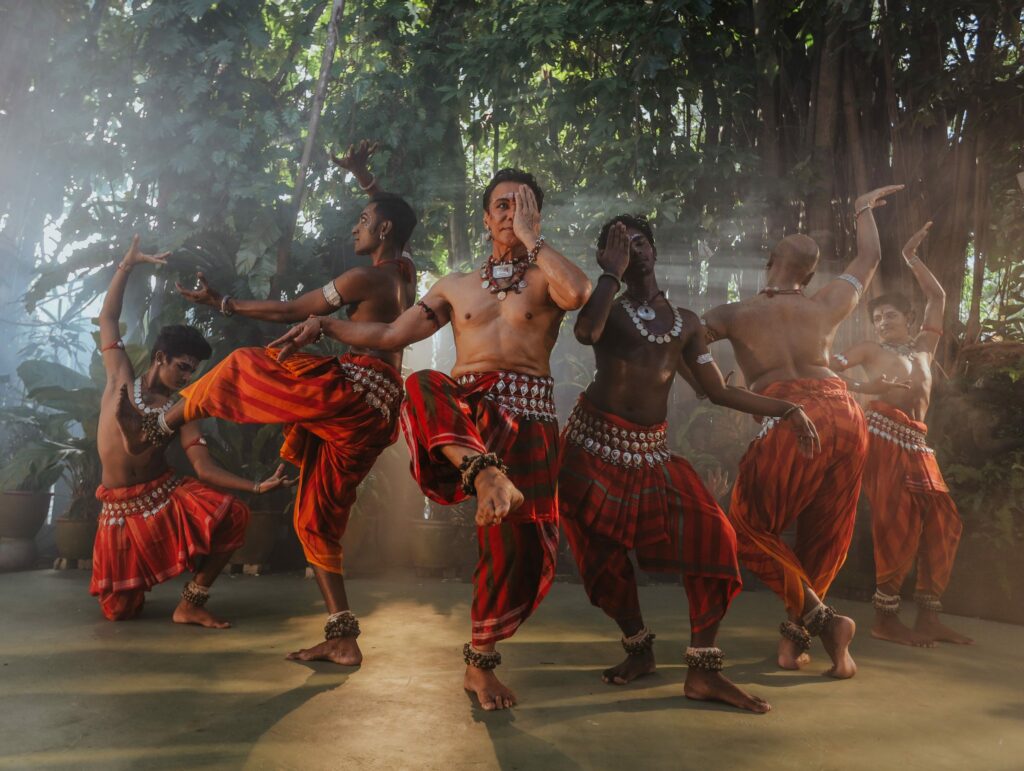
” Where Odissi exponent, Ramli Ibrahim, allows us insights into how Tryambakam was re-envisaged from a solo dance to an all-male group production for the camera “ Ramli ji, why did you feel the need to re-envisage a solo work like Tryambakam into a group work and also adapt it to film? Usually, we would learn the work in India as a solo item and then de-construct it for group work in Sutra. We often do this as we don’t have the luxury of giving the stage exclusively for a solo dance. There are just too many talented dancers in line, waiting to be used! Or the stage is often too big and rather ineffective for a solo dance! Tryambakam was taught to us by my guru-ben, Sujata Misra when we were in Bhubaneswar in 2018. It was one of the two dances by Sujata showcased in Triple Frontiers, an Odissi production that premiered in April 2021, just before our third lockdown. We decided to perform Tryambakam with an all-male cast as the work was essentially ‘tandav’. It so happened that I had a number of young male students from our Outreach program, whose combined talent was waiting to be shown. So, the work had to be ‘re-arranged’ for a group composition. Another opportunity arose to adapt it virtually on film with a relatively good budget. And so, Tryambakam went through several processes of ‘de-construction’. Fundamentally, the latter was inevitable as the work was no longer a solo item. And then, during filming, it had to be further re-envisaged to suit the demands of filming, group rearrangement, and location. What is the starting point when you have to de-construct an existing work? How much do you need to shed, and how much do you need to retain? Actually, in Tryambakam we retained all the dance vocabulary taught to us – we did not shed off any movement. However, we did add new image compositions and montages as sections of the alap were ‘empty’ and we couldn’t have a blank screen, the alap being an essential part of the music. There were also group sections which needed to be re-envisaged as we were no longer dealing with a lone body but several dancers. It would be so boring and unimaginative if the work had merely depicted six solo male dancers doing the same thing! What has it been like to envisage it for the camera? Some key learnings while doing so. We were lucky to find the right director, camera man, and also lighting director, who complimented one another! Eventually, it was the director who had to decide on the camera angles and direct how the footages should be edited. We also requested that some anecdotes and sections be layered or nuanced with allusions to the attributes of Lord Siva. One has to remember, that the filming was done during the lockdown, and this was the main reason we decided to use the premises of Sutra House for the location of all the footages of the six commissioned dance videos. Sivarajah Natarajan, who had been our lighting designer for almost 25 years, had to consolidate all the technical areas of camera, lighting, and sound so that they all contributed artistically towards the shared objective of the final film. We also had to sectionalise Tryambakam so that all areas of Sutra House were effectively utilised. The location is exquisite really; why is location particularly crucial while making dance on film? Sutra House has a wonderful ambience. During the several lockdowns, both Sivarajah and I had the time to concentrate on improving our premises and sprucing up the garden. There were several spots that were photogenic, especially in the early morning light, and these were used to maximum effect. Half of the battle is won when a compelling ambience is utilised with good lighting, natural or enhanced. I think a good ambience gives a scene that distinctive visual effect… The montage sequences at the beginning, were they constructed carefully? Both the montage and link sequences were carefully constructed to give that seamless and professional appeal. As mentioned, we had to augment the work with montages during the alap and this was done at back garden area of our studio. Filming is not physical theatre, and therefore the layering can be ‘artificially’, but artistically constructed. A lot, they say, happens at the editing table… you also played a lot with cool tones and an emphasis on contrasts; what was the thought behind that creative decision? There is only so much work you can do on editing – but if the content is uninteresting or not up to the mark, the final edit will still be poor. Having said that, there is much good contribution, an artistic director can do in the final touch-up, such as the suggestion of the kind of final tones and contrasts that the work should finally be given for that distinctive look. I guess in filming, the director and editor have the ultimate say in how the work will eventually look. The choreographer has to stand aside as ‘let his work go’ as the ball is no longer in his court. This is why I prefer the theatre, where the choreographer is still supreme, in control – and ‘what you see is what you get’, so to speak. This may not be so with filming.
Interview with Thiruchittampalam Ramanan
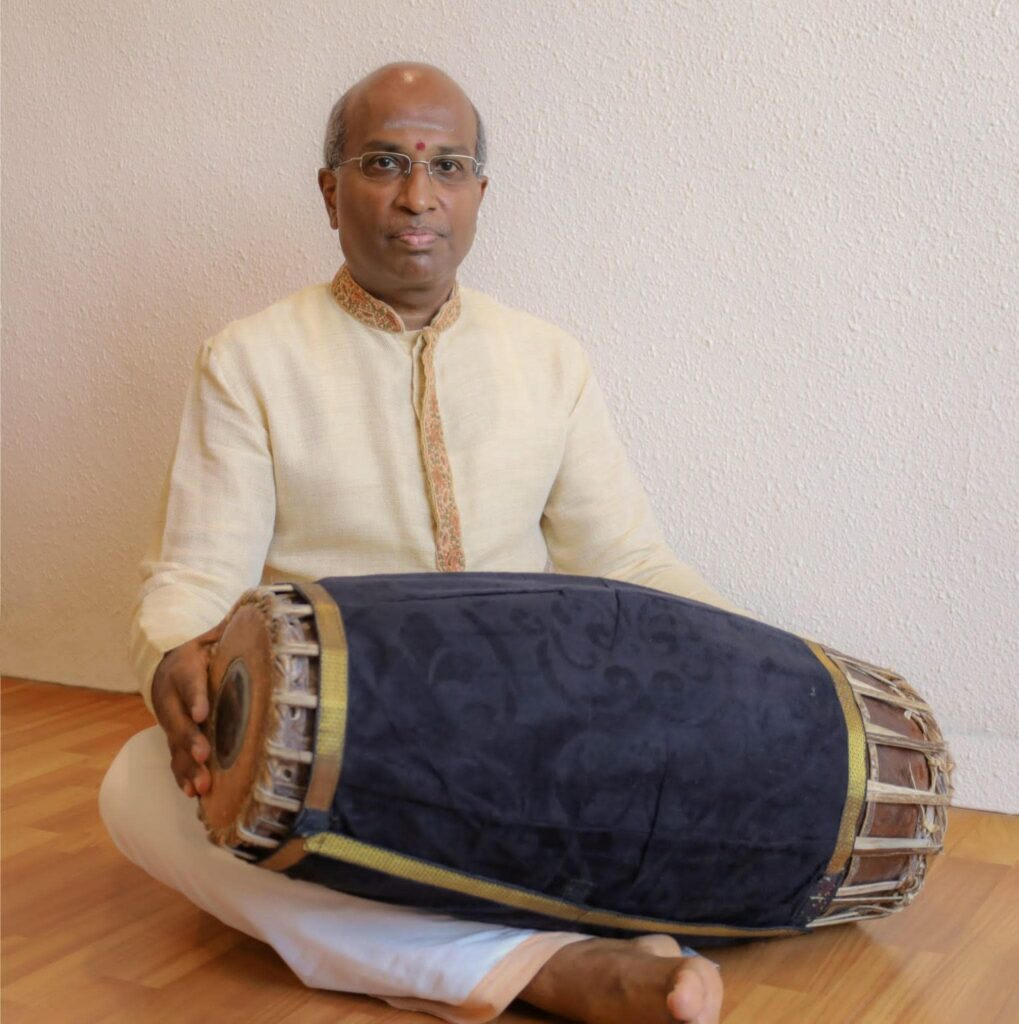
An Interview with Thiruchittampalam Ramanan, considered the Pride of Singapore, a mridangist with over 1500 programmes, in his kitty : By Vidhya Nair Let us start from the very beginning. Tell us about yourself and your family I was born in Malaysia in the 1960s. My father worked for the Malaysian railways and married my mother who was based in Singapore. Eventually, our family settled in Kuala Lumpur (K.L) where I studied before permanently moving to Singapore in the 1980s during my teens. How did you come to be introduced to Carnatic music and the mridangam? Who nurtured your interest? It started with my maternal great-grandfather, Arumugam. He loved Indian Classical music. After he heard that the Music Academy was opening in Madras (now Chennai), he quickly relocated himself from Malaysia to Chennai in the 1930s. He bought a house close to the Academy so that he could attend concerts regularly. He made a serious commitment to study and learn as much as he could.As a retiree, he pursued this knowledge by befriending all book publishers ensuring he would receive the first copy of the first release of any book in the Carnatic Music genre. This resulted in him having a huge collection of rare and acclaimed Carnatic music books. Subsequently, much of his collections were donated to the Music Academy Library in Chennai. He also named his child, my grand uncle, after a famous music composer, Saint Tyagaraja.Although the ancestral roots of my family began in Jaffna, I only visited Jaffna when I went on tour with Apsaras Arts six years ago. A Shiva temple connected with my family still stands in our ancestral village there. I met my wife, Sarada when we were both active in the Singapore Indian Orchestra & Choir (SIOC). She sings and also plays the violin, veena and sitar. My two daughters are also pursuing Carnatic vocal and my elder daughter learnt Bharatanatyam. I am grateful to my family for supporting me to pursue my passion in mridangam. How did you come to learn the mridangam? Tell us about your early learning and teachers? From a young age I was exposed to both Carnatic music and Bharatanatyam. My mother and her sisters learnt both art forms from early classical arts stalwarts of Singapore. They were the pioneer batch who learnt music from the late Pandit Ramalingam together with Vijayalakshmi Sharma and the late V Ramachandran. They also learnt Bharatanatyam from the Bhaskar’s. My grandfather, Dr Balasingham, a pathologist was a patron of the arts and was instrumental in helping K P Bhaskar to perform in K L back in the 1950s. In the early 1960s, my father was posted to Ipoh where he was the President of a local temple. He had the opportunity to learn mridangam soon after he arranged for a mridangam teacher to be brought to Malaya from India. I was drawn to my father’s mridangam at home and used it to accompany my grand-aunt who would sing at home. I was fascinated by its dynamic sound and my interest developed in this nurturing environment. My father further kindled my interest in mridangam by taking me to concerts regularly. I recall watching Madurai Somu and Dr Balamuralikrishna when they performed in K L in the 1970s. We would try to meet the musicians and interact with them. I began learning formally at the age of 12 under a loving guru Thangavelu Vattiyar. In 1980, Flute N Ramani came for a concert in which Karaikudi Krishnamurthy accompanied as a mridangist. My father and I met them and I insisted that I wanted to learn from Krishnamurthy sir after hearing him play. My family encouraged me to continue taking lessons from him throughout my school years. My elder sister became a full time Bharatanatyam teacher with Temple of Fine Arts, Kuala Lumpur till today. Our family treated this pursuit as a divine art, a gift to be nurtured and supported. Several members of my extended family have gone on to pursue music professionally and are promoters in Kuala Lumpur, Perth and elsewhere. Karaikudi Krishnamurthy, your teacher. Share with us your learning years with him? When I met him in 1980 post concert, he told us he had just taken up a position in SIFAS and asked me to take classes there. My father agreed to send me to Singapore. As my father was a Railways employee, I could get free train passage. Initially during school holidays and weekends, I would take the train down on my own and attend Krishnamurthy sir’s classes. As a mridangam student, I would have classes for long hours throughout the day and eventually stayed with sir. He cared for me like his own son and was very loving. SIFAS was at Norris Road then and there weren’t too many students. I was fortunate to meet many Carnatic music stalwarts who performed in Singapore including artistes like K V Narayanaswamy, M L Vasanthakumari, T N Seshagopalan, Dr N. Ramani, Dr L Subramaniam and many more.Krishnamurthy Sir was an amazing and dynamic teacher. He taught spontaneously. He organised many programmes himself and was an active performer both in Singapore and Malaysia. He created korvais in impromptu and taught them along the way to a concert. He expected me to perform what was taught even at these last moments. Over time a group of us formed, my peers were Paskaran, Selvapandian and Devarajan. As I was often called on to practice and perform very regularly, I realised I was in a unique position. Upon Krishnamurthy sir’s insistence, I was exempted from paying fees to SIFAS. I learned under him till he left Singapore in 1988. Apart from playing alongside him on Ghatam or Kanjira at his regular concerts, I was often encouraged to perform as a solo accompanist. Every experience was a lesson in itself. As his live-in companion, he cooked and took care of me. He knew how to motivate; give you challenges and keep you on your toes
From the Desk
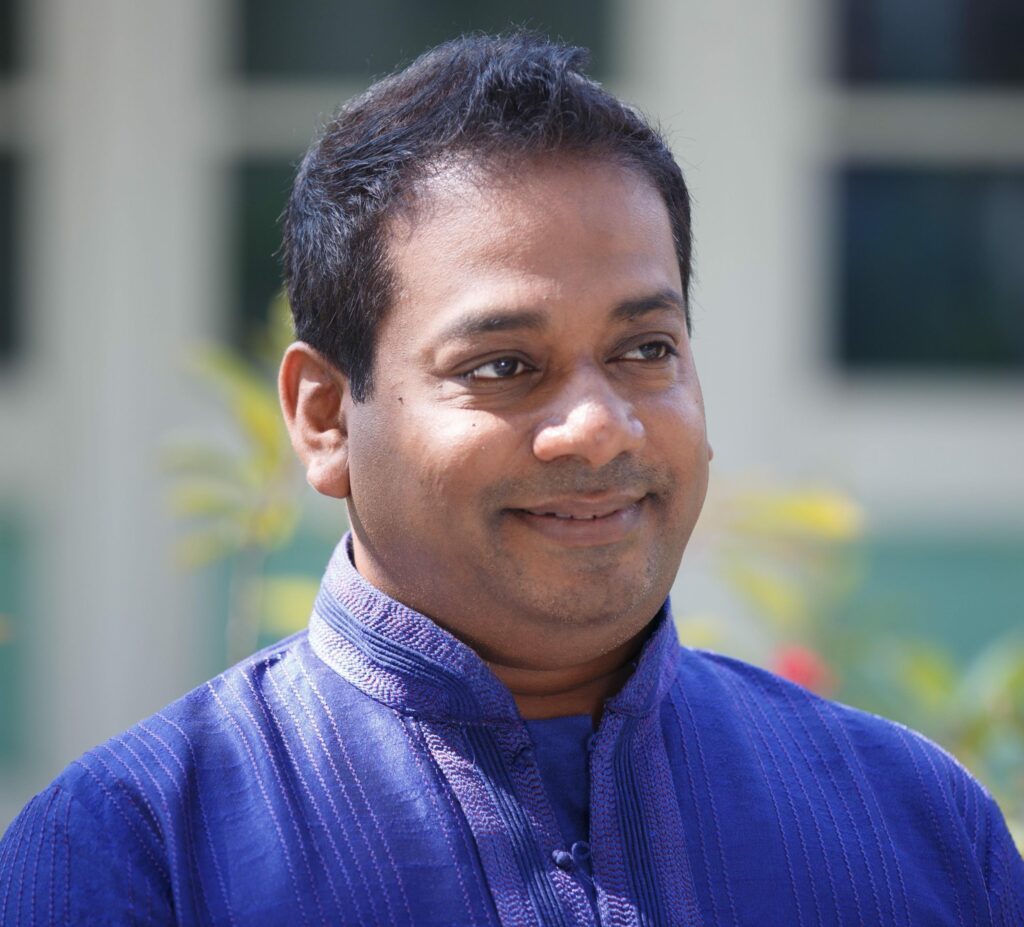
In 2016, with an intent to share – and on a timely, regular basis – the many stories brewing in the house of Apsaras Arts, we launched Aavartana, a newsletter, a periodical, literally inspired by the word, Aavartna, a musical term, which literally means cycle of a set rhythmic pattern. As a monthly periodical that arrived at the end of every month in people’s inboxes, Aavartana became the possibility for us to share, report, relay, the world of Apsaras Arts to our rasikas and readers, across the globe. As an international dance repertory company committed equally to performance and education, Aavartana, brought to our own life, a sense of rhythm, and became that channel of communication for us to converse with the arts community in the written word, and do that, in a systematic manner. After a few editions though, life and work came in our way and in 2020, just as we grappled with a pandemic, we returned to a semblance of structure with Aavartana. But like all good ideas that must be nurtured, we are poised in a moment where we are keen to use our standing and reputation, globally, in a manner that is authentic, honest, inspiring and impactful. And it is precisely with this premise that we are proud to present to you Aavartana in an avatar that is anew. Inspired by core principles of objectivity, empathy, inclusivity and a sense of teh accessible, Aavartana in its new format, is more than a mere newsletter that will bring you stories of Apsaras Arts. As a digital magazine that believes in aggregating and presenting the many trends and narratives that make the world of the Indian performing arts so dynamic and exciting, Aavartana will allow readers the possibility of an overview of the people, things and trends simmering in the world of Indian performing arts, dance in particular. Conscious of our readers, of the rushed world we live in and recognising the way we consume news and features today, Aavartana is also excited to unfurl on social media in a way that allows for quick, easy reading for those on the move and like it short, but also cater to readers who still love that feeling that comes from reading a story written in long-form and one that takes more than five minutes. Every edition will feature a cover story that will shed light on a particular idea that is trending in the world of the arts. Our Portrait section features an in-depth interview with an artiste whose story deserves to be told; in our Point of View section, we invite an expert, an artiste to share their perspective on a subject that is pertinent to the world we are in. Three years ago, in December, we introduced a #iamayoungdancer with an intent to create a platform that essentially shared and amplified stories of young dancers from across the world. Our column, The Bookshelf raises a toast to the idea of books and the world associated with it. In our Travel Diaries, we will bring you slices and stories from our own travels and those of other artiste-friends of ours from across the world. In our opening edition, our editorial team insisted this note from me occupies pride of place. Our Portrait this time is T Ramanan, a mridangam artiste with over 1500 performances, worldwide and truly a pride of Singapore. Lata Pada, Bharatanatyam dancer-choreographer-teacher from Canada, shares her perspectives on the pandemic and its impact on dance, and dancers. In our #iamayoungdancer section, two dancers, Periyachi Roshini from Singapore and Rukshikaa Elankumaram from Australia, have a freewheeling conversation on life in dance, and vice versa. For our The Bookshelf section, we reached out to Maya Kulkarni, New York-based dancer-choreographer and academic, to know what she is reading and how her reading inspires her dance. Our Travel Diaries is an in-depth re-visiting of Apsaras Arts’ tour of France, that helped us build connections, meet new audiences, and make memories. We are excited about you reading all that we have compiled for you and we are hoping to build on this editorial platform so Aavartana becomes a part of your life cycle, too! If you like what you read, do take a moment to show us some love! We are hoping to hear from you! Warmly Aravinth Kumarasamy Artistic Director & Editor, Aavartana.